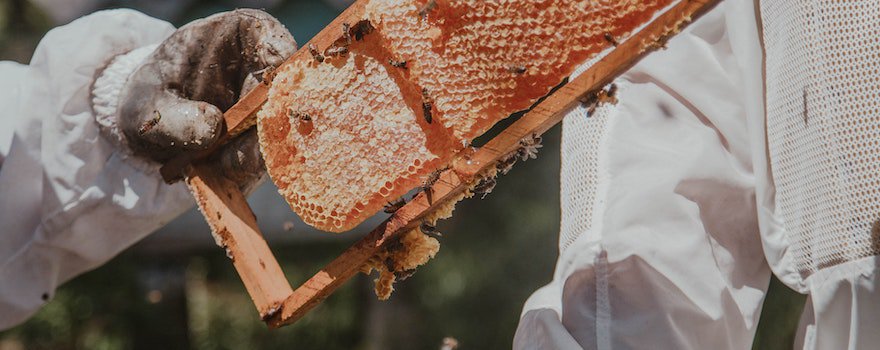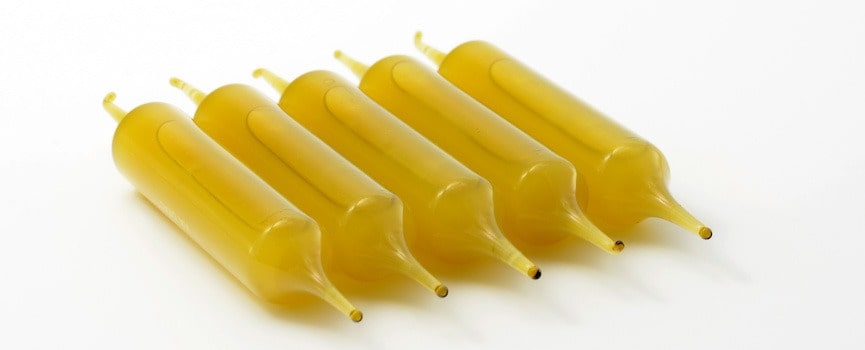BENEFITS OF ROYAL JELLY
✓ Strengthens the immune system
✓ Natural source of antioxidants, anti-aging
✓ Relieves menopause symptoms
✓ Anti-inflammatory
✓ Reduces blood pressure
What is royal jelly?
Royal jelly is a milky secretion produced by bees to feed the larvae of the colony and the queen. It specifically comes from the hypopharyngeal and mandibular glands of the bees. While all larvae benefit from it until they hatch, only the queen consumes it throughout her life.
It is a gelatinous substance ranging from yellowish to whitish – it whitens upon contact with air, especially when collected. This doesn’t sound very appetizing, but don’t worry, it has a tart and very sweet flavor!

The queen of a colony can live 5 to 6 years, while worker bees live about 45 days. Royal jelly is believed to be one of the causes of this queen’s resistance and longevity. It is a particularly rare product, as a hive cannot naturally produce more than 300 g per year.
Thus, even though its use has been documented for centuries, in ancient Egypt, as well as in traditional Chinese medicine, its consumption remained very limited and reserved for a few privileged individuals. It was specifically used to combat fatigue, strengthen the body, and promote longevity. This is also the case in Russia and Eastern Europe, where it is additionally associated with adaptogenic substances.
Today, beekeepers have developed techniques to increase the production of royal jelly and its preservation, notably through a process of lyophilization – or freeze-drying. Its consumption has therefore become more widespread, and it is now easily found in pharmacies, organic and health food stores.
From a nutritional standpoint, royal jelly is particularly rich. Composed of 60% water, its remaining 40% is packed with carbohydrates, proteins, lipids, minerals, vitamins, and amino acids.
This nutritional richness is said to be the source of its numerous medicinal properties, especially its ability to boost our immune system. However, scientific studies proving these claims are still rare, and the majority confirming its properties have been conducted in vitro or on animals.
It is consumed as a dietary supplement, in ampoule form, or fresh. It can also be used in cosmetics, applied to the skin.
Nutritional composition
- Proteins
- Amino acids
- Carbohydrates: fructose and glucose
- Lipids: saturated fatty acids including stearic and palmitic
- Minerals and trace elements: calcium, magnesium, potassium, phosphorus, iron, copper
- Vitamins: B1, B2, B3, B5, B6, B9 or folic acid

Benefits
🛡 Boosts the immune system
Royal jelly is known to boost the immune system and thereby protect the body from viruses and bacteria.
What explains this particular property is the presence of certain fatty acids and proteins in royal jelly, notably the MRJPs (Major Royal Jelly Proteins). These have a anti-bacterial activity and support immune function.
To date, we mostly have in-vitro or animal studies, but the results support an immune system boost.
This study conducted by various Italian universities and the University of Macau, established the immunostimulant and antimicrobial activities of different compounds in royal jelly.
🥝 Natural source of antioxidants, anti-aging
Royal jelly is also a natural source of antioxidants. Some amino acids, fatty acids, and phenolic elements in its composition have a high antioxidant activity. They help to fight against free radicals and cellular aging.
It can notably be used in anti-aging skin treatments since it helps to increase collagen production. Furthermore, it protects the skin from UV damage, one of its main aging factors.
This study from Kyung Hee University in Korea conducted on rats demonstrated that royal jelly helps to increase collagen production.
🌺 Relieves menopause symptoms
Royal jelly can be a natural and effective ally in the fight against menopause-related disorders.
Among the observed symptoms are hot flashes, weight gain, migraines, anxiety, and back pain, which are the most common. Two-thirds of menopausal women are affected by these disorders.
Compounds in royal jelly have estrogenic activity and may help alleviate menopause symptoms. They also promote a good hormonal balance in women. To relieve these disorders, it is also advised to take a maca cure.
This study from Kindai University in Osaka, Japan, conducted on 42 menopausal women, showed that daily consumption of 800 mg of royal jelly for 12 weeks significantly reduced back pain and anxiety.
🌵 Anti-inflammatory
Royal jelly has anti-inflammatory activity that helps combat various types of inflammations. Three fatty acids, in particular, are responsible for this property.
This study conducted in vitro by various Chinese scholars demonstrated the anti-inflammatory capabilities of three fatty acids composing royal jelly.
🍳 Anti-cholesterol
Another property of royal jelly is its ability to lower the level of bad cholesterol in the blood. As a result, it helps to reduce the risk of cardiovascular accidents.
Specific proteins are believed to be involved. Studies have been conducted on both animals and humans, but results need to be confirmed by additional studies.
This study from Chung Shan Medical University in Taiwan conducted on 40 people showed that those who consumed 3 g of royal jelly per day for a month saw their level of bad cholesterol decrease.
☁️ Reduces blood pressure
Royal jelly helps to reduce blood pressure, thereby protecting our heart and promoting good circulation.
It acts directly on the walls of veins and arteries by making them more flexible. Thus, it lowers blood pressure and improves circulation. Some proteins within it are thought to be responsible for this property.
This study from Fuzhou University in China demonstrated that a dietary supplement made from various bee products contributed to reducing blood pressure in rats, although the exact role of royal jelly could not be determined.

How to consume royal jelly?
Favor organic and French royal jelly
It is recommended to favor organic royal jelly and of French origin to ensure better quality, traceability, and absence of pesticides. Its composition and nutritional benefits vary depending on the environment and the flora around the hives.
Today, products originating from Asia flood the market. Imported at low cost, their production conditions and health benefits are questioned.
Beyond health and environmental aspects, buying a French product helps support a quality industry facing numerous challenges. Overwhelming import competition, biodiversity reduction, new predators, pesticides…
French beekeepers have come together within the Group of Royal Jelly Producers, which, notably with the creation of a label, aims for excellence in product production and preservation.

Fresh
Consuming fresh royal jelly is the best way to benefit from its nutritional properties. A product that is neither processed nor frozen is a guarantee of quality, and the fatty acids and proteins behind its benefits are all the more preserved.
You can get it directly from a beekeeper, or in an organic store. It should be kept in the refrigerator.
Lyophilized
Lyophilized royal jelly is obtained by dehydrating the fresh product. It is mainly available in the form of capsules and tablets, suitable for those who do not appreciate its taste.
In ampoules

This is the form most easily found in stores, pharmacies, para-pharmacies, and organic shops… The ampoules are ideal for starting a cure as the dosage is exact. Be sure to choose fresh royal jelly ampoules from the French sector. Check the ingredients carefully, as manufacturers tend to add other compounds, including sugar.
Dosage
⚖️It is recommended to consume 300 mg to 1.2 g of fresh royal jelly per day, and up to 400 mg of lyophilized jelly.
⏳Generally, it is recommended to do three-month cures during seasonal changes when the body may be weakened.
🍯Fresh: a teaspoon per day in the morning
🥃In ampoule form: one ampoule diluted in a glass of water in the morning
💊In lyophilized tablet form: according to the tablet dosage
Contraindications and Side Effects
There is a contraindication for people with allergies to other bee products, honey, pollen, wax. Allergens may also be present in products containing pesticides, causing asthma.
It is also not recommended for pregnant or breastfeeding women. Medical advice should be sought regarding children.
History, Culture, and Market
Creating Orphan Hives
All hives produce royal jelly, but in quantities too insufficient for human consumption. Nurse bees secrete only the necessary volume for rearing and do not store it.
To increase hive production, beekeepers have developed new techniques. They use “orphaning”, which involves removing the queen from a colony so that nurse bees start producing more royal jelly.
Production in Four Steps
- Grafting: outside the hive, larvae aged 12 to 36 hours are placed in artificial royal cells on a frame
- Introduction: this frame is placed in the orphaned hive. The nurse bees will enhance the cells and abundantly supply royal jelly to the larvae.
- Harvesting: after three days, when the cells have reached their maximum abundance, the frame is removed.
- Extraction: royal jelly is collected from each cell. A hive can thus provide up to 1000 g of jelly per year.
As for its price, French-origin royal jelly costs around 2300 euros per kg, while imported royal jelly averages 300 euros per kg.



